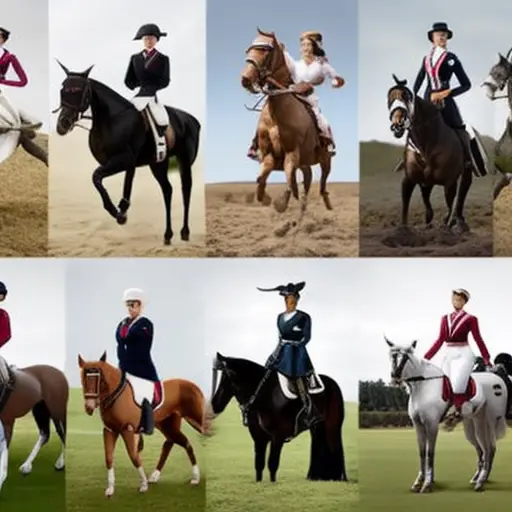The Relationship Between Horsemanship and Leadership Skills

Do you want to become a more effective leader? Look no further than the world of horsemanship.
The relationship between horsemanship and leadership skills is undeniable. By examining the lessons and techniques used in handling horses, you can gain valuable insights into communication, trust-building, patience, and non-verbal cues.
This article explores the surprising parallels between horsemanship and leadership, revealing how mastering the art of working with horses can help you become a better leader in any field.
The Importance of Clear Communication in Horsemanship and Leadership
You need to prioritize effectively conveying your message to ensure successful horsemanship and leadership. Clear communication is an essential aspect of effective leadership.
When working with horses, it’s crucial to communicate clearly with your equine partner to establish trust and mutual understanding. Horses are highly perceptive animals, and they rely heavily on non-verbal cues and body language. Therefore, it’s essential to be aware of your own body language and to communicate with clarity and consistency.
In horsemanship, clear communication involves using precise and concise cues to convey your intentions to the horse. This includes using consistent cues for specific movements or actions and ensuring that your aids are clear and easy for the horse to understand. Effective leadership in horsemanship requires being confident, assertive, and consistent in your communication with the horse. This not only helps in training and guiding the horse but also builds a strong bond and partnership based on trust and respect.
Moreover, the importance of clear communication extends beyond the horse-human relationship. In leadership, effective communication is vital for inspiring and motivating team members, setting clear expectations, and ensuring the successful execution of tasks. A leader who can communicate clearly and effectively can articulate their vision, provide guidance and feedback, and foster a positive and productive work environment.
Building Trust and Respect: Lessons From Horsemanship for Leaders
To establish a strong foundation for effective leadership, leaders must cultivate trust and respect, just as horsemanship requires building a bond with the horse. Trust and respect are the cornerstones of any successful relationship, whether it’s between a leader and their team or a horse and its rider. In both cases, clear communication and establishing boundaries are crucial elements in building this foundation.
Here are three key lessons from horsemanship that leaders can apply to build trust and respect:
-
Active Listening: Just as a rider must listen to their horse to understand its needs and emotions, leaders must actively listen to their team members. By giving them a voice and truly hearing what they’ve to say, leaders can foster an environment of trust and respect.
-
Consistency: Horses thrive on consistency and predictability. Similarly, leaders must be consistent in their actions and decisions. This consistency helps to establish clear boundaries and expectations, earning the trust and respect of their team.
-
Empathy: Horses are highly intuitive creatures and can sense the emotions of their riders. Leaders who show empathy towards their team members create a safe space where individuals feel understood and valued. This empathy builds trust and respect within the team.
Developing Patience and Persistence: Horsemanship Skills for Effective Leadership
As a leader, developing patience and persistence is crucial to effectively navigate challenges and achieve goals.
In horsemanship, these skills are honed through building resilience, nonverbal communication, and cultivating trust and mutual respect with the horse.
Building Resilience Through Horsemanship
Building resilience through horsemanship requires putting in the time and effort to work through challenges and overcome obstacles. It isn’t always an easy task, but the rewards are worth it. By developing patience and persistence in horsemanship, you’re also building important leadership skills that can be transferred to other areas of your life.
-
Patience: Working with horses teaches you the value of patience. Horses can be unpredictable and may not always respond the way you expect. Learning to remain calm and patient in these situations is crucial for building resilience and effective leadership.
-
Persistence: Horses can be stubborn and resistant at times. It takes persistence to continue working with them, even when faced with setbacks. Developing persistence in horsemanship translates to the ability to persevere and overcome challenges in other aspects of life.
-
Emotional Intelligence: Building resilience through horsemanship also involves developing emotional intelligence. Horses are highly perceptive animals and can pick up on your emotions. Learning to manage your emotions and communicate effectively with your horse is essential for building a strong partnership and leadership skills.
Nonverbal Communication in Leadership
You need both patience and persistence in order to develop effective nonverbal communication skills as a leader. Developing rapport and understanding with your team is crucial, and horses can teach you valuable lessons in this area.
Horses are incredibly perceptive animals and are sensitive to body language cues. They can sense your emotions and respond accordingly. When working with horses, you must learn to control your body language and communicate your intentions clearly. This skill translates directly into leadership, as your team members also pick up on your nonverbal cues.
Trust and Mutual Respect
To establish trust and mutual respect with horses, it’s essential to cultivate patience and persistence as a leader. Horses are sensitive creatures that can easily pick up on our emotions and intentions. Building a strong foundation of trust and mutual respect is crucial for effective leadership in horsemanship. Here are three key points to consider:
-
Building Resilience:
-
Horses can be unpredictable and may test your patience. It’s important to remain calm and composed in challenging situations.
-
Developing resilience will help you handle setbacks and obstacles with grace and determination, earning the trust and respect of your horse.
-
Effective Communication:
-
Horses rely on nonverbal cues and body language to understand us. Mastering the art of effective communication will enhance your ability to connect with your horse.
-
Clear and consistent signals will help establish trust and a deeper level of understanding between you and your equine partner.
-
Patience and Persistence:
-
Horses are creatures of habit and may take time to adapt to new situations or commands. Patiently repeating and reinforcing your expectations will help them learn and trust your leadership.
-
Consistent and persistent efforts will build a solid foundation of trust and mutual respect, allowing you to become an effective leader in horsemanship.
The Power of Non-Verbal Communication in Horsemanship and Leadership
Using non-verbal cues effectively is crucial in both horsemanship and leadership. In horsemanship, horses communicate primarily through body language and non-verbal cues. They’re highly attuned to subtle movements, gestures, and energy, which can convey trust, respect, and direction. Similarly, in leadership, non-verbal communication plays a vital role in effectively conveying messages, building trust, and inspiring others.
In horsemanship, understanding and utilizing non-verbal cues allows for clear communication with the horse. Horses are incredibly perceptive beings and can pick up on even the slightest shift in body language. Through the use of non-verbal cues such as posture, hand signals, and eye contact, a horse can be directed and guided with precision and clarity. By maintaining a calm and confident demeanor, a horse is more likely to respond positively and trust your leadership.
In leadership, non-verbal communication is equally important. As a leader, your body language speaks volumes and can influence how others perceive and respond to you. By adopting an open and confident posture, making eye contact, and using appropriate hand gestures, you can convey authority, confidence, and approachability. Non-verbal cues such as active listening, nodding, and mirroring can also show empathy and understanding, fostering meaningful connections with your team.
Mastering the power of non-verbal communication in both horsemanship and leadership allows for effective and impactful interactions. By understanding and utilizing non-verbal cues, you can build trust, establish clear communication, and inspire others to follow your lead. Whether working with horses or leading a team, non-verbal cues are a powerful tool in creating successful partnerships and achieving desired outcomes.
Mastering the Art of Listening: Horsemanship Techniques for Leaders
By paying attention to and interpreting the subtle cues of a horse’s movements and behavior, leaders can gain valuable insights and enhance their ability to listen effectively. Listening is a crucial skill for leaders, as it fosters effective communication and understanding within a team. In horsemanship, mastering the art of listening isn’t just about hearing the words being spoken, but also understanding the unspoken messages conveyed through body language and behavior.
Here are three listening techniques that leaders can learn from horsemanship:
-
Be present: Just as horses can sense when a rider is distracted or preoccupied, team members can also tell when a leader isn’t fully engaged. Practice being present in the moment, giving your undivided attention to the person speaking.
-
Observe body language: Horses communicate primarily through body language, and so do humans. Pay attention to the non-verbal cues of your team members, such as facial expressions, posture, and gestures. This will provide valuable insights into their thoughts and feelings.
-
Practice active listening: Actively listen by paraphrasing and summarizing what the other person has said. This not only demonstrates that you’re engaged, but also helps clarify any misunderstandings or miscommunications.
Overcoming Challenges: Horsemanship and Leadership in Times of Difficulty
During times of difficulty, you must remain resilient and adaptable as a leader, for your horsemanship skills have taught you the importance of perseverance and flexibility. Just as you have faced challenges while working with horses, you’ll encounter obstacles and crises in your role as a leader. However, by adapting your horsemanship skills to leadership challenges, you can effectively navigate through difficult times.
One of the key aspects of horsemanship that can be applied to leadership during times of crisis is the ability to remain calm and composed. Horses are incredibly perceptive animals and can sense fear or anxiety in their handlers. Similarly, your team members can pick up on your emotions and reactions. By staying calm and composed, you can provide a sense of stability and reassurance to those around you, allowing them to trust in your leadership.
Another important skill that horsemanship teaches is the ability to think on your feet and make quick decisions. Horses are unpredictable creatures, and situations can change rapidly when working with them. As a leader, you may also encounter unexpected challenges that require immediate action. By practicing quick decision-making and adaptability in your horsemanship, you can apply these skills to your leadership role, finding innovative solutions and guiding your team through difficult times.
Lastly, horsemanship emphasizes the importance of clear communication and establishing trust. Horses rely on non-verbal cues and body language to understand their handlers. Similarly, as a leader, effective communication and building trust are crucial during times of crisis. By utilizing your horsemanship skills to communicate clearly and establish trust with your team members, you can foster a sense of unity and collaboration, enabling your team to overcome challenges together.
Establishing Boundaries and Setting Expectations: Horsemanship Lessons for Leaders
To effectively lead, you must establish clear boundaries and set expectations for your team, just as you’d in horsemanship. By doing so, you create a foundation of trust and structure that fosters teamwork and enables everyone to work towards a common goal.
Here are three key lessons from horsemanship that can help you in establishing boundaries and setting expectations as a leader:
-
Consistency is key: Horses thrive on consistency and clear communication. Similarly, as a leader, it’s essential to consistently enforce the boundaries and expectations you have set. This ensures that everyone understands what’s expected of them and there’s no confusion or ambiguity.
-
Lead by example: Horses are highly perceptive animals, and they respond best to leaders who lead by example. As a leader, you must embody the qualities and behaviors you expect from your team. By setting a positive example, you inspire and motivate others to follow suit.
-
Communicate effectively: Just as you communicate with your horse through non-verbal cues and body language, effective communication is crucial in leadership. Clearly articulate your expectations, provide constructive feedback, and actively listen to your team members. This open and honest communication fosters trust and allows for better collaboration.
Cultivating Emotional Intelligence: Horsemanship and Leadership Skills
Cultivating emotional intelligence is a crucial aspect of both horsemanship and leadership skills.
As a leader, non-verbal communication skills are essential for understanding and connecting with your team members. By building trust and empathy, you create a safe and supportive environment where individuals feel valued and understood.
Additionally, managing emotions effectively allows you to make rational decisions, handle conflicts, and inspire others to reach their full potential.
Non-Verbal Communication Skills
As you learn about non-verbal communication skills in horsemanship, you’ll gain valuable insights into cultivating emotional intelligence and developing effective leadership skills. Non-verbal cues and body language play a crucial role in horsemanship and can teach us a great deal about how to communicate with others in a non-verbal way. Here are three key points to consider:
-
Awareness: Horsemanship teaches us to be acutely aware of our own body language and non-verbal cues. Horses are highly perceptive creatures and can pick up on even the subtlest of signals. By practicing awareness, we can become more attuned to the non-verbal messages we’re sending to others.
-
Presence: Horses respond best to calm and assertive leaders who are fully present in the moment. This means being aware of our own emotions and projecting a sense of calm and confidence through our body language. By cultivating presence, we can create a positive and effective leadership presence.
-
Authenticity: Horses are incredibly sensitive to incongruence between our words and our non-verbal cues. They can sense when we aren’t being authentic or genuine. By practicing authenticity in our non-verbal communication, we can build trust and establish strong connections with others.
Incorporating these lessons from horsemanship into your leadership approach can greatly enhance your ability to communicate effectively and cultivate emotional intelligence.
Building Trust and Empathy
Develop trust and empathy by practicing active listening and building authentic connections with horses, as this will greatly enhance your leadership skills and emotional intelligence. Building confidence and fostering teamwork are key components of both horsemanship and effective leadership. Horses are highly sensitive animals that can sense your emotions and intentions, making them excellent teachers in developing these skills.
To build trust, it’s essential to approach horses with patience, understanding, and respect. By actively listening to their cues and responding appropriately, you can establish a foundation of trust. Horses can also help you develop empathy by teaching you to read and understand non-verbal communication. This skill is crucial in leadership, as it allows you to better understand the needs and emotions of your team members.
In addition, working with horses requires teamwork and collaboration. Just like in a leadership role, you must establish clear communication and set boundaries to ensure a harmonious partnership. By practicing these skills with horses, you can transfer them to your professional life, creating a more inclusive and supportive work environment.
Managing Emotions Effectively
To effectively manage your emotions, you must understand and regulate them while working with horses, as this can greatly enhance your leadership skills. Horses are highly perceptive animals and can sense and mirror the emotions of those around them. By learning to manage your emotions effectively, you can create a calm and positive environment, which is essential for building trust and establishing a strong connection with the horse.
Here are three key points to consider when managing your emotions in horsemanship:
-
Recognize and acknowledge your feelings: Take the time to identify and understand your emotions before engaging with the horse. This self-awareness allows you to approach the situation with clarity and composure.
-
Practice emotional regulation: Develop techniques to regulate your emotions, such as deep breathing or visualization exercises. This helps you stay calm and composed, even in challenging situations.
-
Manage stress effectively: Horses are incredibly sensitive to stress, so it’s important to manage your own stress levels. Practice relaxation techniques and self-care to ensure you approach horsemanship with a clear mind and a balanced emotional state.
Frequently Asked Questions
Are There Any Specific Horse Breeds That Are Known to Be Better for Developing Leadership Skills?
There aren’t any specific horse breeds known to be better for developing leadership skills. Leadership skills can be developed through horsemanship with any breed, and these skills can be transferred to other areas of life.
How Can Horsemanship Skills Be Transferred to Leadership in Other Areas of Life?
Developing empathy and building trust are key skills in both horsemanship and leadership. By honing your horsemanship skills, you can learn to understand and connect with others, gaining valuable insights into effective leadership in various areas of life.
Can Horsemanship Skills Be Learned and Developed by Anyone, Regardless of Their Prior Experience With Horses?
Anyone can learn and develop horsemanship skills, regardless of prior experience with horses. It may be challenging at first, but the benefits of learning trust and communication are invaluable for both horsemanship and leadership in other areas of life.
Are There Any Specific Exercises or Activities That Can Help Leaders Improve Their Non-Verbal Communication Skills?
To improve non-verbal communication skills, engage in horsemanship activities. These exercises will teach you to read and respond to subtle signals, building trust and empathy. The relationship between horsemanship and leadership skills is undeniable.
How Can Horsemanship Skills Help Leaders Navigate and Overcome Challenges in the Workplace or Other Environments?
To navigate and overcome workplace challenges, horsemanship skills can help you build trust and rapport with others. Additionally, they can enhance your decision making abilities by teaching you to be calm, assertive, and responsive in high-pressure situations.
Conclusion
In conclusion, horsemanship and leadership skills go hand in hand. Clear communication, trust-building, and patience are key elements in both realms. Non-verbal cues, active listening, resilience, boundary setting, and emotional intelligence are also important in both horsemanship and leadership.
Like a well-tuned symphony, the harmony between horsemanship and leadership creates a powerful and transformative experience. Just as a skilled rider guides a horse with finesse and grace, a knowledgeable and insightful leader inspires and guides their team. This evokes a symphony of success.

Join Davina Gardea on a journey into the world of horsemanship. With a deep passion for horses and years of experience, Davina shares invaluable insights and techniques to enhance your connection with these magnificent creatures. Explore the art of riding, training, and nurturing a profound bond with horses at diedgone.com.





